The Port of Hilo is located on the eastern coast of the Island of Hawaiʻi, nestled in Hilo Bay. It serves as the island's primary commercial deepwater port and is a key gateway for both cargo and cruise ship passengers. The port provides a vital link for the island's economy, handling a diverse range of goods.
For cruise passengers, Hilo is a cherished destination known as the gateway to the island's dramatic volcanic landscapes and lush, tropical rainforests. Its location offers convenient access to some of Hawaii's most spectacular natural wonders, making it a highlight of any Hawaiian cruise itinerary. While primarily industrial, the port provides stunning views of the bay and the distant slopes of Mauna Kea on clear days.
The top attraction is the magnificent Hawaiʻi Volcanoes National Park, located about a 45-minute drive from the port. This UNESCO World Heritage site is home to Kīlauea, one of the world's most active volcanoes, offering dramatic landscapes, steam vents, and hiking trails.
Closer to town, you can visit the easily accessible Rainbow Falls (Waiānuenue), just a 10-minute drive from the port. It is best viewed in the morning when rainbows often appear in the mist. A short drive further inland takes you to Boiling Pots, a series of turbulent pools along the Wailuku River.
For a stunning waterfall experience, head north for about 25 minutes to ʻAkaka Falls State Park, which features a short, paved loop trail through a lush rainforest to view the 442-foot ʻAkaka Falls. Nearby, you can also explore the serene Liliʻuokalani Park and Gardens, a beautiful Japanese garden right on Hilo Bay.
Last updated on June 20, 2025
The town of Volcano, situated at the edge of the national park, is a primary nearby destination. Located about 30 miles (48 km) from the port, the drive takes approximately 45-60 minutes and serves as the main hub for exploring the Kīlauea caldera.
Another popular trip is along the Hamakua Coast north of Hilo to see lush scenery and waterfalls. This scenic drive can take you to attractions like the World Botanical Gardens or smaller historic plantation towns.
For a unique experience, visitors can drive towards the Saddle Road to reach the visitor center on Mauna Kea. The Maunakea Visitor Information Station is about an hour's drive from Hilo and offers incredible stargazing opportunities and high-altitude landscapes, though the summit requires a 4-wheel drive vehicle.
Last updated on June 20, 2025
The Hilo cruise port is located at Pier 1 in Hilo Harbor, which is an industrial and commercial port. It is situated approximately 2-3 miles (about 3-5 km) east of downtown Hilo.
Due to the distance and the industrial nature of the surroundings, it is not recommended to walk to the city center. Cruise lines often provide shuttle buses to downtown Hilo, and taxis, tour operators, and ride-sharing services are readily available at the pier.
The port terminal itself has minimal amenities, with few to no shops or restaurants in the immediate vicinity. Cruise ships typically dock directly at the pier, so tendering is not usually required.
Last updated on June 20, 2025
The official currency in Hilo is the United States Dollar (USD). Other currencies, such as the Euro, are not accepted for transactions.
Major credit cards are widely accepted at most hotels, restaurants, and shops. ATMs are readily available throughout Hilo, especially in the downtown area and at local banks, for cash withdrawals. Currency exchange services are not commonly needed for most visitors and can be difficult to find outside of the airport.
Last updated on June 20, 2025
Hilo is generally considered a safe destination for tourists. Standard safety precautions, such as being aware of your surroundings and securing your valuables, should be practiced. Avoid leaving items visible in rental cars, as break-ins can occur at popular tourist spots and trailheads.
The primary safety concerns are related to the natural environment. When visiting Hawaiʻi Volcanoes National Park, always stay on marked trails and heed all warnings from park rangers, as volcanic fumes (vog) and unstable ground can be hazardous. When swimming or near the ocean, be mindful of strong currents and high surf, especially on unguarded beaches. It is safe to explore independently, though guided tours are often recommended for the volcanoes for their expertise and logistical ease.
Last updated on June 20, 2025
Hilo has a tropical rainforest climate and is known as one of the wettest cities in the nation, which contributes to its lush, green scenery. Rain can occur at any time of year but often comes in the form of brief, passing showers followed by sunshine.
Temperatures are consistently warm year-round, typically ranging from the low 70s to the mid-80s Fahrenheit (21-29°C). Visitors should pack lightweight clothing, comfortable walking shoes, and a reliable rain jacket or umbrella. Sunscreen, sunglasses, and a hat are also essential for protection during sunny periods.
The official hurricane season for the Central Pacific runs from June through November, but powerful storms are historically infrequent in Hawaii. Visitors should always monitor weather advisories, but major disruptions are rare.
Last updated on June 20, 2025
Transportation is necessary to get from the port to Hilo's main attractions. Options include rental cars, pre-booked shore excursions, taxis, and ride-sharing services.
For public transit, the island's 'Hele-On Bus' system offers an affordable way to get around, though its schedule may not be ideal for the tight timelines of cruise passengers. You can find routes and schedules on the official Hele-On Bus website. Most visitors opt for rental cars for the most flexibility in exploring destinations like the national park.
Last updated on June 20, 2025
The best shopping is found in historic Downtown Hilo, which is lined with charming, locally-owned shops, boutiques, and art galleries. This area is perfect for finding unique gifts and souvenirs. A highlight for many visitors is the Hilo Farmers Market, a vibrant open-air market offering a huge selection of tropical fruits, flowers, local food, and handmade crafts. The market is open daily, with the largest number of vendors present on Wednesdays and Saturdays.
Local specialties to look for include macadamia nuts, locally grown coffee, tropical fruit jams, and handcrafted items made from native woods. Aloha wear, such as shirts and dresses, is also a popular purchase. Prices in shops are fixed, and bargaining is not part of the local culture.
Last updated on June 20, 2025
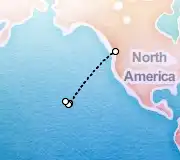
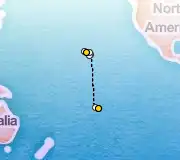
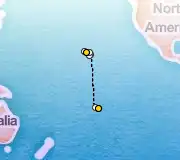
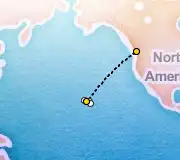
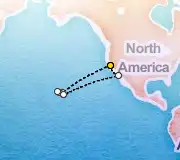
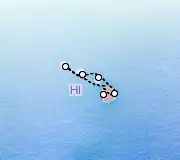


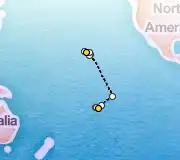

Showing 2 ships in the area
No ships scheduled in port today.
Overall Hilo is fairly expensive as a port of call. The diagram below shows the monthly average cost per day for cruises visiting Hilo. Cruises visiting Hilo during the the peak season of summer are significantly more expensive than the low months of winter and fall.
Want to hear about the best deals and cruise tips every week? Sign up for our free weekly VIP Newsletter, customized exactly to your preferences!